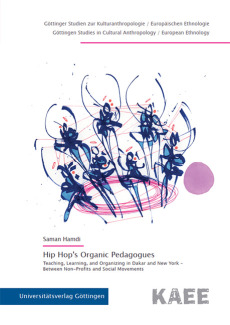Saman Hamdi
Hip Hop’s Organic Pedagogues
Teaching, Learning, and Organizing in Dakar and New York – Between Non-Profits and Social Movements
Reihe: European EthnologyWhat can Hip Hop culture and its art forms (dance, rap, DJing, graffiti/style writing) contribute to the development of individuals, communities, and even society? To answer this question, this book delves into Hip Hop activism in social work, education, and political movements in New York and Dakar. It follows the work of Hip Hop practitioners who teach their art forms in high schools, in neighborhood centers, in prisons, and at scene events. These activists use Hip Hop culture’s Afro-diasporic practices for community building and social justice struggles in the hope for a better future. Drawing on 40 interviews and extensive ethnographic research, the author looks at various projects of resistance. Building on Gramscian terminology, he differentiates between Hip Hop’s organic intellectuals (movement organizers), and the culture’s organic pedagogues (educators). The latter are DJs, rappers, dancers, and graffiti artists (style writers), who bring their cultural practices into classrooms. The book follows these pedagogues and their students in their own words and critically explores their teaching methods, social-justice-driven curricula, and mentoring approaches. This helps to understand how Hip Hop education is carried out in formal and institutional settings, but also in more informal spaces of different scenes, within the culture’s communities of practice. The book also explores how Hip Hop’s organizers build non-profit organizations, such as cultural centers or federations, and how they establish careers around their crafts. The author analyzes four types of Hip Hop non-profits and how their founders struggle with financial limitations and state repression. The dynamics of the larger field of Hip Hop activism are taken into account, such as funding cycles, competition between activists, political oppression, or censorship, as well as the challenges of Hip Hop’s “NGO-ization.” Finally, the “Y”en a Marre” movement in Senegal, which was founded by some of the country’s most popular rappers, serves as a case study to evaluate whether Hip Hop can effectively drive social change through social movement organizing and mobilization. Parallel to such political organizing in Senegal, activists in New York draw from movement traditions such as the Black Panthers or the Young Lords Party and engage in climate justice and antiracist movements. Thus, on the one hand, the book hopes to inspire Hip Hop activists to critically reflect on their practice and learn from others. On the other hand, it contributes to the academic understanding of the culture’s potential (and its limitations) for social justice education and for building organizations, communities, and movements.

